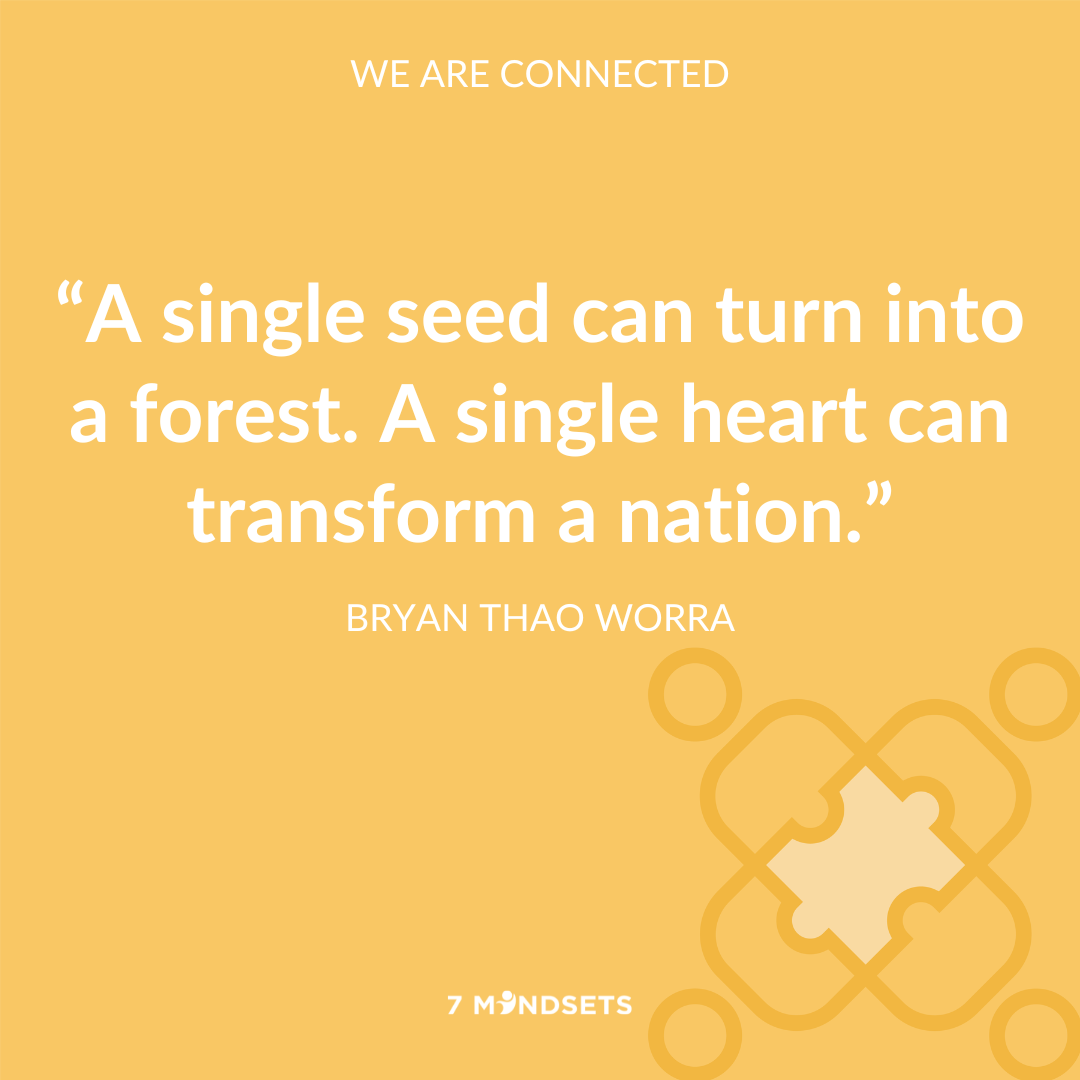
Before we look at what may be holding this group back, let’s look at the 8% who do accomplish their goals to better understand what these high achievers do differently. The individuals in this 8% come from all walks of life. They are married, single, or divorced; highly educated or high school dropouts; and middle class, wealthy, or even poor by most standards. They are comprised of a variety of ages and ethnicities from all over the world. But one key commonality among this group is this: a similar set of success-oriented mindsets that guide their thoughts and actions.
The fact is, no matter where you are in life or where you came from, you’ve got the ability to set goals, effectively change your mindset, and achieve them.
A surefire way to determine whether you need a mindset tune-up is to answer the question: Are you regularly accomplishing your goals and living your dreams? If you answered “yes,” read on, and you’ll probably recognize why. If you said “no,” the following seven steps could be game-changing for you.
7 Ways to Change Your Mindset Today:
- Accept that your thinking needs adjusting – We’ve all had goals and dreams that didn’t unfold the way we hoped or expected. When this happens repeatedly, we start to wonder what we need to change. But rarely do we look inside at our own thinking as the place to start making changes.
We live in a skillset-driven society that emphasizes learning new skills and improving the ones we’re weakest at. This often fosters the belief that we need more education in order to achieve our goals. Some people go back to school, others take seminars and workshops or read books, always looking for that silver bullet skillset that will make everything fall into place.
Don’t get me wrong, I’m not downplaying the value of skillsets; but more often, it’s our mindsets that need adjustment. The good news is, it’s a lot less expensive and much faster to change your mindsets than to go learn a new skill. So step one is simply to acknowledge that you’re going to work on your mindsets first.
- Identify your counter-mindsets – Mindsets are formed through prior experiences and emotional milestones, and the mindsets that aren’t producing the results you want are called counter-mindsets. Some examples of these are self-doubt, limiting beliefs, and any other negative thoughts that get in the way of your fulfillment.
Around 65,000 thoughts go through our minds each day. Unfortunately, in the case of most people, most of them are negative. These Automatic Negative Thoughts (ANTs) occur so often that you’re probably not even aware of them (most of us aren’t).
For example: You know that little voice that points out irresponsible spending choices when you’re looking at your monthly budget? Or makes disparaging comments when you look in the mirror? We all know that voice. It makes you hesitate before approaching someone you’d like to meet. It makes you think twice before starting a business or considering a career change.
All of us have different ANTs, and without knowing it, we’re habitually allowing them to destroy our dreams. It’s hard to remain positive when that little voice is constantly spouting off and saying things like, “I can’t talk to her,” “I’m not smart enough,” “I’m out of shape,” “I’m not qualified” … yada, yada, yada.
The way to start exterminating the ANTs in your head is to begin paying attention to them. Notice when you hear that disparaging voice and recognize how frequently it happens. More than likely, you’ll find that your limiting thoughts can be narrowed down to a few key themes. Taking note of this is a major step because we can’t change what we haven’t acknowledged.
- Flip the switch – Once you’ve identified your top negative thoughts, you need a way to stop them from holding you back. A good technique for this is something called “flip the switch,” which moves thoughts from negative to positive.
For years, every time I looked in the mirror, all I saw were my flaws. Finally, I started practicing the exact opposite reaction – flipping the switch. I’d look in the mirror and force myself to say, “You look good!” It took some time to get used to it, but the reality is that positive thoughts and negative thoughts can’t occupy the same space, so I was giving my ANTs an eviction notice.
Another technique I find effective is called the “if/then” approach. Once you identify when your ANTs typically show up, apply a thought process that allows you to essentially think yourself past them. Here’s an example: Say you plan to go for a walk after dinner to get more exercise, but when dinner is over, your ANT shows up. If you start to hear the voice in your head that says you’re too tired, too full, or you’ll never lose the weight anyway, then walk to the closet immediately and put on your running shoes.
Often, just taking one positive step in the right direction is enough to shut those ANTs up. Prepare yourself by creating a list of if/then statements ahead of time.
- Understand your “why” – Changing your mindsets takes work because formed habits aren’t easy to break. This is especially true since many of our most harmful habits and counter-mindsets were established when we were kids, and we’ve been doing things the same way ever since. Understanding your “why” is about starting fresh and deciding on one goal or dream that, when you achieve it, will mean a transformational change. Losing weight. Being happier at work. Improving your relationship with your companion. Identify something that could make a significant impact on your life. After all, if it’s going to take work to make it come true, it better be meaningful, right?
Once you identify what your “why” is, write down on paper or in a notebook why it really matters to you. Not on a computer … on paper in your own handwriting. This is an important part of building your motivation.
- Realize that motivation and willpower are not enough – Most people incorrectly believe that motivation and willpower are all that’s needed to achieve their goals. And no wonder they do, since it’s common advice you hear from friends and family to motivation gurus and life coaches.

The latest brain research reveals that willpower is like a gas tank. You start with a full tank, but you deplete your supply each time you use it. Here’s what I mean:
You’re trying to eat healthier, then get to work and find Girl Scout cookies next to the fruit bowl. What do you do? Tap into your willpower and resist the cookies. Good for you! Then you plan to go to the gym after work but end up staying later to deal with a customer issue. Your willpower is already depleted, and the added stress of not following your original plan doesn’t help. Do you end up going to the gym? You know the answer because it has happened to all of us.
It doesn’t take long to simply give up and abandon our goals when we rely on motivation and willpower to achieve them. They aren’t always enough. That’s why 25% of people give up on a goal after the first week, and 60% quit after the first month.
High achievers understand this reality, which is why step five is simply about recognition … that is, recognizing that achieving your goals isn’t about white knuckling your way to success.
By accepting this fact, you’ll stop mentally punishing yourself for stumbling or failing to stick to your plan–which will leave you emotionally freer to optimistically try again tomorrow! (We’ll talk more about this in step 7.)
- Start small so you can finish big – This may sound counter-intuitive, but one of the best ways to change your mindsets and realize your dreams is through setting ridiculously tiny, utterly achievable goals.
How tiny? How about this: one push-up.
If your big goal is to get daily exercise, then your small, attainable goal is to do a single push-up each day. If you want to reduce stress in your life, your tiny goal might be to meditate for one minute every night. If you want more affection with a loved one, your mini goal could be one extra hug or kiss.
Each of these examples requires almost no motivation or willpower to accomplish. And yet, each is a positive step. Here is the trick. Decide that your tiny goal is the minimum and that you can do more if you feel up to it. A lot of the time, you’ll do more and will feel great because you’re overachieving. Some days you may do the minimum, and you’ll still feel great because you’ve met your goal.
How can these tiny goals actually make an impact? It’s because massive change requires small steps, repeated daily, which create momentum and yield positive cumulative results. The top 8% of achievers understand this, but most people never try this strategy because they think it seems pointless to start so small. Wrong! Over time, consistently hitting your small goals will form new mindset habits, and that’s real progress toward revamping your thinking so you can reach your biggest dreams.
- Get comfortable with the “F” word – The steps for how to change your mindset that I’ve outlined so far will help you move forward with confidence toward achieving more of your goals and dreams. However, it’s critical to understand that it will be hard work.

When most people hit a wall, they make an excuse or give up. High achievers realize that the only thing that will keep them from their goals is to stop trying … so they don’t! They know that they’ll encounter obstacles and even fail along the way. What separates them from the other 92% is that they prepare for failure mentally. They know it’s coming, and it doesn’t scare them or make them give up. When failure happens, they seek feedback and make adjustments to get back in the game.
You can do this by giving yourself permission to fail. It will take the pressure off getting a perfect end result, and you can be ready to learn from missteps and make adjustments that will keep you moving forward.
Changing your mindsets doesn’t happen by accident. It happens by choice, and these seven steps should help get you on the right track.
Currently supporting 1.3 million students and 84,000 teachers, 7 Mindsets’ solution is proven-effective to improve student behavior, engagement, and academic success. Combining a mindsets-based approach with authentic engagement supports educator and student wellbeing and creates lasting change.
Want to learn more about 7 Mindsets? Let’s Get Started!







